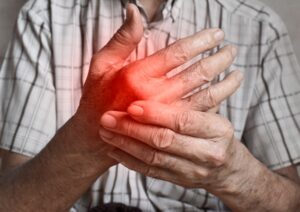April is Sjögren’s Awareness Month, a time dedicated to raising awareness about a complex autoimmune condition that often goes undiagnosed or misdiagnosed due to its wide range of symptoms. While dry eyes and dry mouth are the hallmark features of Sjögren’s syndrome, many people are surprised to learn that joint pain and arthritis-like symptoms are also very common. In fact, Sjögren’s frequently overlaps with other rheumatic conditions like rheumatoid arthritis (RA) and lupus, making proper diagnosis and treatment a crucial part of long-term health and well-being.
At Pacific Arthritis, our team of expert rheumatologists is experienced in identifying and managing overlapping autoimmune conditions. This blog explores the connection between Sjögren’s syndrome and arthritis symptoms, how patients can recognize the signs, and which treatment options—including infusion therapy and ultrasound-guided injections—may help provide relief.
What Is Sjögren’s Syndrome?
Sjögren’s syndrome is an autoimmune disease in which the body’s immune system mistakenly attacks its own moisture-producing glands. This leads to dryness in areas such as the eyes and mouth, but the condition can also affect the joints, lungs, kidneys, nervous system, and other organs. Sjögren’s may occur on its own (primary Sjögren’s) or in conjunction with other autoimmune diseases such as rheumatoid arthritis or systemic lupus erythematosus (secondary Sjögren’s).
Because of its wide-ranging symptoms and overlapping conditions, Sjögren’s is often underdiagnosed or confused with other disorders. Recognizing the link between Sjögren’s and joint symptoms is critical to obtaining an accurate diagnosis and timely treatment.
Overlapping Symptoms Between Sjögren’s and Arthritis
One of the reasons Sjögren’s syndrome is so commonly misdiagnosed is because it shares key symptoms with other inflammatory diseases. Among the most common overlaps is arthritis-like joint pain.
Common Overlapping Symptoms Include:
- Joint Pain and Stiffness: Many individuals with Sjögren’s report pain in the small joints of the hands and wrists, similar to rheumatoid arthritis.
- Morning Stiffness: Like RA, Sjögren’s can cause stiffness that is more pronounced in the morning or after periods of inactivity.
- Swelling and Inflammation: Patients may experience visibly swollen joints, often mistaken for early-stage rheumatoid arthritis or lupus arthritis.
- Fatigue: Persistent fatigue is a hallmark of Sjögren’s and is also commonly seen in inflammatory arthritis.
- Raynaud’s Phenomenon: Reduced blood flow to the fingers and toes, causing them to turn white or blue in response to cold or stress, can occur in both Sjögren’s and other autoimmune rheumatic diseases.
Due to the overlapping symptoms, many patients with Sjögren’s are initially treated for arthritis before a complete diagnosis is made. That’s why it’s important to work with a rheumatology specialist who can evaluate the full scope of symptoms and run targeted diagnostic tests.
Diagnostic Tools and the Role of a Rheumatologist
Diagnosing Sjögren’s syndrome and differentiating it from other rheumatic diseases requires a comprehensive approach. At Pacific Arthritis, we use a combination of blood tests, physical exams, symptom history, and imaging tools to evaluate joint inflammation and systemic symptoms.
Common Diagnostic Tools Include:
- Blood tests to look for autoantibodies such as SSA/Ro and SSB/La, which are often present in Sjögren’s.
- Erythrocyte sedimentation rate (ESR) and C-reactive protein (CRP) to assess inflammation levels.
- Ultrasound imaging to identify and evaluate joint inflammation in real-time.
- Lip biopsy and Schirmer’s test to confirm gland involvement and dryness symptoms.
When joint pain and stiffness are present, and symptoms are resistant to over-the-counter treatments, a referral to a rheumatologist can help identify the presence of overlapping autoimmune arthritis and tailor an effective treatment plan.
Treatment Options for Joint Inflammation in Sjögren’s
While there is no cure for Sjögren’s syndrome, treatment focuses on symptom management and reducing inflammation. For joint symptoms, especially when they mimic or overlap with rheumatoid arthritis, effective options include:
1. Infusion Therapy
Biologic drugs delivered via infusion therapy target the immune system at a cellular level to reduce inflammation and slow disease progression. Infusion therapy may be used in cases where joint inflammation is severe or unresponsive to traditional oral medications.
- Particularly helpful for RA-Sjögren’s overlap cases.
- Medications like rituximab and infliximab are often used to control systemic and joint symptoms.
- Infusions are administered under the supervision of a rheumatology team for safety and effectiveness.
2. Ultrasound-Guided Injections
For localized joint inflammation, ultrasound-guided corticosteroid injections can deliver targeted relief.
- Provides precise medication delivery directly into the inflamed joint.
- Reduces swelling and improves mobility quickly.
- Ideal for patients with painful joints not responding to oral medication or topical treatments.
3. Disease-Modifying Antirheumatic Drugs (DMARDs)
Traditional DMARDs, such as hydroxychloroquine or methotrexate, may be used in milder cases to manage systemic inflammation and protect joints from long-term damage.
4. Lifestyle and Supportive Therapies
In addition to medical treatments, supportive strategies such as physical therapy, anti-inflammatory diets, and proper hydration can significantly improve quality of life.
Why Sjögren’s Awareness Month Matters
Sjögren’s Awareness Month is an opportunity to highlight the complexity of this autoimmune disease and to encourage earlier diagnosis and more effective treatment strategies. Raising awareness of the overlap between Sjögren’s and arthritis symptoms can help patients get the care they need faster, prevent joint damage, and improve long-term health outcomes.
Too often, patients are told their joint pain is “just arthritis” when, in fact, it may be part of a broader autoimmune picture. Empowering both patients and providers with this knowledge can lead to more accurate diagnoses and better treatment experiences.
Conclusion
Recognizing the signs of Sjögren’s syndrome, especially when they overlap with arthritis symptoms, is key to receiving the right treatment and support. At Pacific Arthritis, our team of experienced rheumatologists is here to provide expert care for complex autoimmune conditions, including those with overlapping diagnoses. Whether you’re dealing with joint pain, fatigue, or systemic inflammation, we offer advanced diagnostic tools and treatment options such as infusion therapy and ultrasound-guided injections to help you feel your best.
If you’re experiencing persistent joint symptoms or suspect an autoimmune condition like Sjögren’s, don’t wait. Call (310) 297-9221 to schedule a consultation at our offices in Los Angeles or Santa Monica, and let us help you get the answers and relief you deserve.




